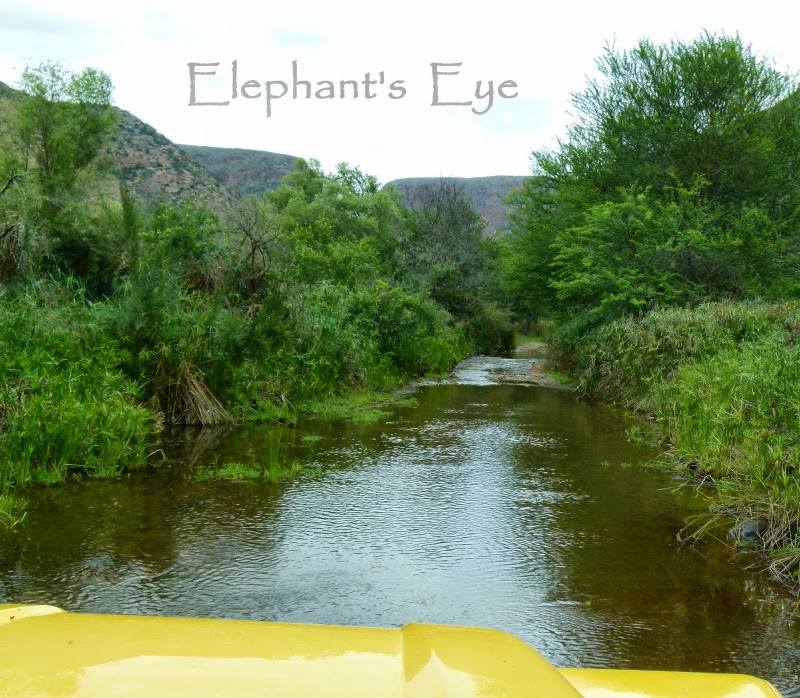Baviaanskloof, and on to Willowmore
by Diana Studer
- gardening for biodiversity
in Cape Town, South Africa
We were planning to go to Baviaanskloof from Addo-today-we-have-warthogs
but that was when the mountain fire brought us home in hurry. In December 2010 we
did go to the Baviaanskloof Conservation Area, which is 189,000 ha. We
start at
the east end.
 |
| The road less travelled Baviaanskloof |
We needed a permit and a high-clearance vehicle for this route. Through 12 river crossings and over mountain passes. Feeling adventurous. Until an African taxi, loaded with people and pulling a trailer of luggage, passed us, heading for the city of Port Elizabeth.
 |
| Leopard-friendly in Baviaanskloof with onion for seeds (the surrounding mountains prevent contamination) and 'mutton' resting in the shade of the thorn-tree |
We are vegetarian, but the Karoo is famous for its mutton.
The sheep browse on Karoo bossies, including wild rosemary. On the
mountain slopes above the farms are wild leopards. Waging a running battle
against gin-traps. This is the leopard-friendly mutton you can buy in our
Woolworth’s shops. Nature conservation breeds Anatolian sheep-dogs, who keep
the leopards
safely away.
 |
| We stop carefully for tortoises |
 |
| Owl rock in Baviaanskloof Hers and his |
I leaned, to show you My Owl.
 |
| The Baviaanskloof River |
Baviaanskloof was created to conserve many different
vegetation types, including fynbos with pincushion proteas Leucospermum cuneiforme on ‘some remarkably flat
plateaus, part of what is known as the African Land Surface’ from Baviaans
geology.
 |
| Cotyledon velutina (thanks to Kumbula Nursery for the plant ID) with a Noorsveld succulent |
 |
| Proteas in Baviaanskloof Pincushion Leucospermum cuneiforme and a pink Leucadendron |
‘The Baviaanskloof Subtropical Thicket Restoration Pilot
Project. Planting spekboom/Portulacaria cuttings in a wide variety
of degraded thicket types and across a climatic gradient. Environmental factors
affecting spekboom survival are investigated by:
Fencing some sites to exclude herbivores
Planting spekboom at different densities, or different sized cuttings
Burning fossil fuels across the planet appears to be linked
to global warming. All signatories to the Kyoto Protocol have agreed to reduce
greenhouse gases. Developing countries can sell sequestered carbon (removed
from the atmosphere and stored in plants)
Spekboom grows rapidly and sequesters large amounts of
carbon dioxide in the process. This pilot project aims to establish how much
carbon can be sequestered by restoring degraded thicket, using cost effective
methods, but also ensuring that biodiversity returns to this landscape.’
Text from the signboard. BGIS SANBI Subtropical Thicket
Ecosystem Project
We work to reduce
our own carbon footprint by planting spekboom cuttings wherever our garden
offers gaps.
 |
| Baviaans Subtropical Thicket Restoration Project The First World's Carbon Credits in action To the left of the solar-powered electric fence, enclosed against browsing herbivores |
Baviaanskloof is named for the baboons.
 |
| Baboons of Baviaanskloof |
 |
| Baviaanskloof road Bottom left Grasnek Mountain Pass |
Hope we return here one day. The Willow Historical Guest
House. Built as the Victorian home of the Dutch Reformed minister. We
dined, alone, in the original dining-room. Accommodation for guests is newly
built, but using architectural salvage doors and windows. So we got both the
charm and the comfort!
 |
| Willowmore Hotel |
Willowmore is the western end of Baviaanskloof.
 |
| Milkweed |
And so we reach Hunting-for-lions-in-the-Karoo-National-Park.
Pictures by Jurg and Diana Studer
of Elephant's Eye on False Bay
(If you mouse over teal blue text, it turns seaweed red.
Those are my links.
To read or leave comments, either click the word Comments below,
or click this post's title)

Everything is extraordinary.
ReplyDeleteEnjoyed this Baviaanskloof adventure, even though the wild leopards sound scary. P. x
ReplyDeleteElusive and nocturnal, it would be a huge privilege to actually see a wild leopard!
DeleteLeopard-friendly mutton: I never thought I would hear that phrase. What a fascinating place! The plant with the bell-shaped flowers is fascinating!
ReplyDeletethe bell is a much more flamboyant relative of this http://eefalsebay.blogspot.com/2013/07/pigs-ears-and-blotanical-2.html
DeleteCotyledon orbiculata
Oh how I wish I had a vehicle to drive through Baviaanskloof with
ReplyDeleteGreat adventurous stuff, all showing how very different our world is. Off to do some mundane planting in the border.
ReplyDeleteDiana what a beautiful, wild place with so much thought about conservation...I love the owl rock and the idea of the spekboom planting.
ReplyDeleteWhat a fantastic adventure ! Just the thought of a tortoise crossing the road in front of you is wild !
ReplyDeleteDiana, your landscape shots are breathtaking. I have such vague ideas of what Africa should look like. Never having been there or really knowing too much about it. It's amazing to me to actually see all those mountains and peaks and lush growth.
ReplyDelete